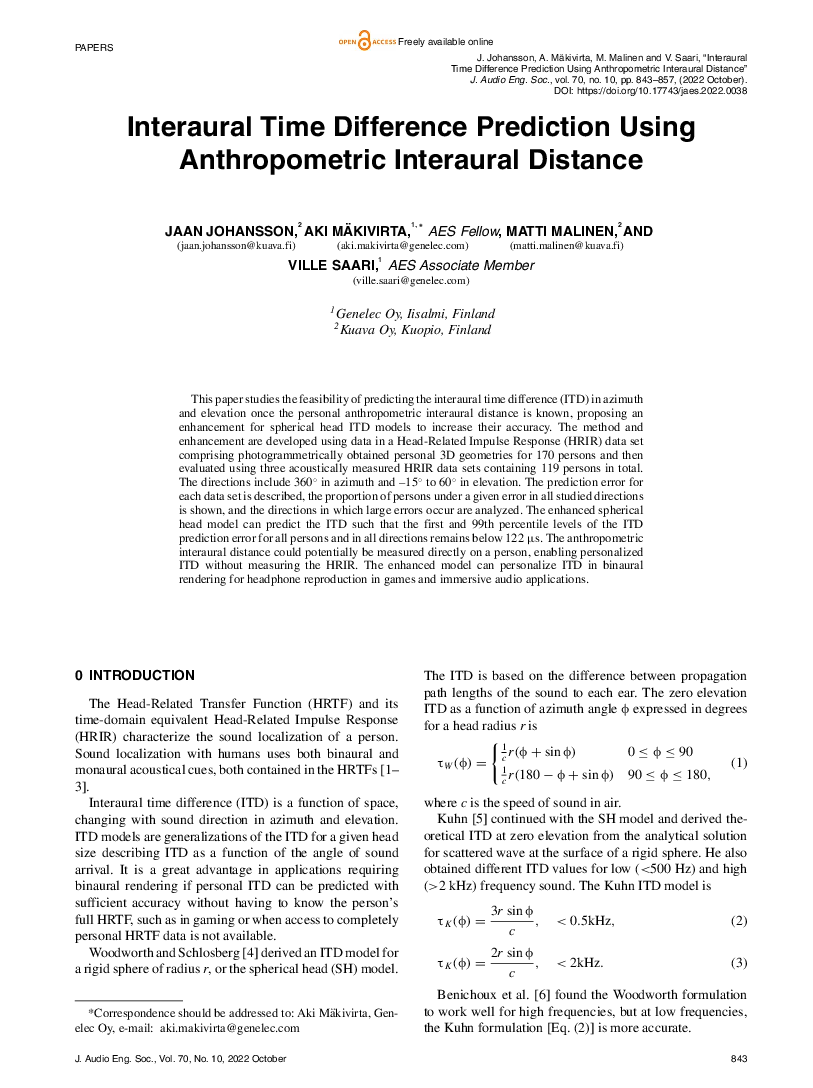Home / Publications / E-library page
You are currently logged in as an
Institutional Subscriber.
If you would like to logout,
please click on the button below.
Home / Publications / E-library page
Only AES members and Institutional Journal Subscribers can download
This paper studies the feasibility of predicting the interaural time difference (ITD) in azimuth and elevation once the personal anthropometric interaural distance is known, proposing an enhancement for spherical head ITD models to increase their accuracy. The method and enhancement are developed using data in a Head-Related Impulse Response (HRIR) data set comprising photogrammetrically obtained personal 3D geometries for 170 persons and then evaluated using three acoustically measured HRIR data sets containing 119 persons in total. The directions include 360° in azimuth and –15° to 60° in elevation. The prediction error for each data set is described, the proportion of persons under a given error in all studied directions is shown, and the directions in which large errors occur are analyzed. The enhanced spherical head model can predict the ITD such that the first and 99th percentile levels of the ITD prediction error for all persons and in all directions remains below 122 µs. The anthropometric interaural distance could potentially be measured directly on a person, enabling personalized ITD without measuring the HRIR. The enhanced model can personalize ITD in binaural rendering for headphone reproduction in games and immersive audio applications.
Author (s): Johansson, Jaan; Mäkivirta, Aki; Malinen, Matti; Saari, Ville
Affiliation:
Genelec Oy, Iisalmi, Finland; Kuava Oy, Kuopio, Finland
(See document for exact affiliation information.)
Publication Date:
2022-10-06
Import into BibTeX
Permalink: https://aes2.org/publications/elibrary-page/?id=22011
(1210KB)
Click to purchase paper as a non-member or login as an AES member. If your company or school subscribes to the E-Library then switch to the institutional version. If you are not an AES member Join the AES. If you need to check your member status, login to the Member Portal.

Johansson, Jaan; Mäkivirta, Aki; Malinen, Matti; Saari, Ville; 2022; Interaural Time Difference Prediction Using Anthropometric Interaural Distance [PDF]; Genelec Oy, Iisalmi, Finland; Kuava Oy, Kuopio, Finland; Paper ; Available from: https://aes2.org/publications/elibrary-page/?id=22011
Johansson, Jaan; Mäkivirta, Aki; Malinen, Matti; Saari, Ville; Interaural Time Difference Prediction Using Anthropometric Interaural Distance [PDF]; Genelec Oy, Iisalmi, Finland; Kuava Oy, Kuopio, Finland; Paper ; 2022 Available: https://aes2.org/publications/elibrary-page/?id=22011
@article{johansson2022interaural,
author={johansson jaan and mäkivirta aki and malinen matti and saari ville},
journal={journal of the audio engineering society},
title={interaural time difference prediction using anthropometric interaural distance},
year={2022},
volume={70},
issue={10},
pages={843-857},
month={october},}